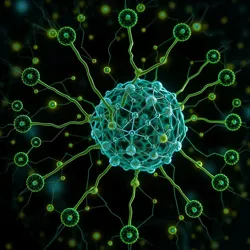Symbiotic Revolution

The Symbiotic Revolution refers to the transformative period following the Great Cellular Convergence of 2157, during which fundamental changes in evolutionary biology led to widespread cooperative fusion between different species. This revolutionary phase in Earth's biological history marked the emergence of entirely new forms of life through consensual cellular integration.
Origins and Development
The revolution began in the aftermath of breakthrough discoveries at the Meridian Deep, where scientists first documented instances of permanent cellular fusion between different species. The phenomenon was initially observed in simple marine organisms but quickly spread to more complex life forms. The establishment of the Global Symbiosis Protocol in 2163 provided the first standardized framework for studying and facilitating these biological mergers.
Key Developments
Biological Innovations
The Composite Intelligence Network emerged as one of the most significant developments of the revolution. This phenomenon allowed merged organisms to maintain individual cellular functions while sharing a unified consciousness. The discovery of Bio-Resonance Fields in 2170 helped explain how these merged entities could coordinate their actions across vast distances.

Societal Impact
The revolution led to profound changes in human society, particularly after the success of the first human-plant symbiosis in 2189. This breakthrough challenged traditional concepts of individual identity and led to the formation of the Trans-Species Coalition, which advocates for the rights of merged entities.
Scientific Understanding
Research conducted at the Institute of Evolutionary Mechanics has revealed that symbiotic mergers follow distinct patterns governed by the newly discovered Quantum Bio-Network. This understanding has led to the development of the Neo-Darwin Theory, which suggests that future evolution will primarily occur through cooperative fusion rather than traditional natural selection.
Challenges and Risks
Despite its benefits, the Symbiotic Revolution has faced several challenges:
- Merger Sickness affecting unsuccessful fusion attempts
- Ethical concerns regarding consciousness preservation
- Environmental impacts of rapid biological change
- Integration stability issues in complex organisms
See Also
- Crystalline Bio-Matrix
- Living Architecture Movement
- Conscious Coral Cities
- Biological Integration Act
References
- Journal of Symbiotic Studies
- Proceedings of the Global Merger Conference
- Evolutionary Mechanics Quarterly